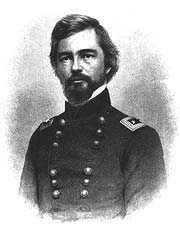Isaac Stevens
 |
| Isaac Ingalls Stevens served as the first governor of the Washington Territory and played a large role in Indian relations in the mid-19th century. Image © 2002 www.clipart.com. |
Friend or foe?
As the first governor of the Washington Territory, Isaac Ingalls Stevens was assigned by the federal Office of Indian Affairs to carry out the new reservation policy. History views him in a contradictory light because of his work.
To some, especially many Indians who found their tribes forced to reservation land, Stevens was a zealous force. He pressured natives into giving over their land in various treaties. He was driven by a desperate desire to secure a transcontinental railroad from Minnesota to Washington in the 1850s. To that end, he would cajole, threaten, and apply every pressure at his disposal to get native nations to sign over their land. He was quite successful in this mission. Perhaps his biggest coup was the Walla Walla Council of 1855. For less than 3 cents an acre, land occupied by the Walla Wallas, Nez Perce, Umatilla, and Cayuse was ceded to the government. In exchange for the assurance of safety, a small payment, and a promise of goods and supplies, the Plateau Indians gave up a quarter of each of the states of Washington, Oregon, and Idaho, a total of 64 million acres, for $1.2 million.
On the other hand, some argue that Stevens was a defender of the Indian nations dislocated by his treaties. Many of the treaties were almost immediately broken by white settlers in the Washington Territory. That dismayed Stevens. The politics of the time considered the sacrifice of Indian rights for the good of many—the white settlers—an acceptable tradeoff. In the face of this, Indian uprisings were inevitable among tribes like the Nez Perce, who had signed the treaties but were frustrated by those agreements not being held. The cavalry charges at Stevens' disposal were there to put down Indian uprisings, not to enforce Indian rights. The situation frustrated Stevens. He completed his term as governor in 1857 and chose to serve as the territory's delegate to Congress. He knew the badly abused Indian treaties could be salvaged only in Congress.
That Stevens sought a cerebral solution is no surprise. Born in 1818 in Massachusetts, Stevens graduated first in his U.S. Military Academy class at West Point. Considered a brilliant and strong-minded man, he served in the Mexican War during the 1840s. In 1853 he headed the surveying party charged with exploring a location for a transcontinental railroad route between Michigan and Puget Sound on the Washington coast. Later that year he was appointed the first governor of the Washington Territory. At age 35, he remains the youngest governor in Washington history.
After leaving the governor's post, Stevens served five years in Congress until the Civil War broke out in 1861. He returned to military service, first as a colonel of a New York regiment and then as a brigadier general, leading volunteer forces. He was killed in battle on horseback Sept. 1, 1862, at the Battle of Chantilly (VA). He was promoted posthumously to major general.
Stevens' legacy lives on. Stevens County, WA, is named after him, and his son, Hazard, wrote a history of the Washington Territory.
Fort Stevens, the first fort built at the mouth of the Columbia River, also bears his name. The fort had the distinction of being the only continental U.S. fortification to be shelled since 1812 when a Japanese submarine fired at it in early 1942. All shells missed, and because the sub was out of range, Fort Stevens didn't return fire. After World War II Fort Stevens was deactivated and later became a state park.
next > |



